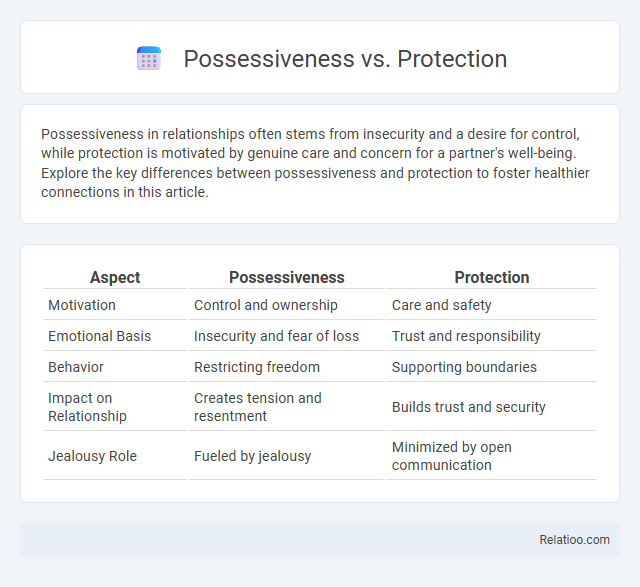Possessiveness in relationships often stems from insecurity and a desire for control, while protection is motivated by genuine care and concern for a partner's well-being. Explore the key differences between possessiveness and protection to foster healthier connections in this article.
Table of Comparison
| Aspect | Possessiveness | Protection |
|---|---|---|
| Motivation | Control and ownership | Care and safety |
| Emotional Basis | Insecurity and fear of loss | Trust and responsibility |
| Behavior | Restricting freedom | Supporting boundaries |
| Impact on Relationship | Creates tension and resentment | Builds trust and security |
| Jealousy Role | Fueled by jealousy | Minimized by open communication |
Understanding Possessiveness and Protection
Understanding possessiveness involves recognizing it as an emotional response where one may feel a need to control or claim ownership over someone or something, often leading to jealousy or insecurity. Protection, on the other hand, is motivated by care and concern, aiming to safeguard the well-being and safety of loved ones without restricting their freedom. Your ability to distinguish between possessiveness and protection ensures healthier relationships built on trust rather than control.
Key Differences Between Possessiveness and Protection
Possessiveness centers on controlling or owning someone, often driven by insecurity and fear of loss, whereas protection involves caring for Your loved one's safety and well-being without infringing on their autonomy. Protection is motivated by genuine concern and respect, fostering trust and freedom, while possessiveness can lead to jealousy and restriction. Understanding these key differences helps cultivate healthy relationships based on mutual respect rather than control.
Psychological Roots of Possessiveness
Possessiveness in relationships often stems from deep-seated fears of abandonment and insecurity, rooted in early attachment experiences and perceived threats to emotional bonds. Psychological research highlights that possessiveness is driven by the need for control to alleviate anxiety about losing a valued connection, contrasting with protection, which is motivated by genuine care and concern for a partner's well-being. Distinguishing possessiveness from protection involves recognizing possessiveness as a self-centered behavior aimed at ownership, while protection prioritizes empathy and respect within healthy emotional boundaries.
Healthy Forms of Protection in Relationships
Healthy forms of protection in relationships emphasize respect for personal boundaries while fostering emotional security and trust between partners. Unlike possessiveness, which often manifests as control or jealousy that undermines individuality, protective behaviors are rooted in care and mutual understanding without restricting freedom. Embracing healthy protection enhances communication and creates a safe space where both partners feel valued and supported.
Signs of Possessiveness in Partners
Signs of possessiveness in partners include excessive jealousy, controlling behaviors, and constant monitoring of the other's activities or social interactions. This possessiveness often manifests as checking messages, dictating who their partner can spend time with, and displaying insecurity through frequent accusations or mistrust. Understanding these signs helps differentiate healthy protection, which respects boundaries, from possessiveness that undermines autonomy and emotional well-being.
How Protection Enhances Emotional Security
Protection enhances emotional security by creating a safe environment where individuals feel valued and cared for, fostering trust and reducing anxiety. Unlike possessiveness, which often triggers control and fear of loss, protection emphasizes respect and boundaries that nurture healthy relationships. This supportive approach strengthens emotional bonds by promoting openness and mutual understanding rather than confinement.
When Protection Turns Into Control
Protection morphs into control when boundaries become restrictions, limiting autonomy under the guise of care. Possessiveness reflects an unhealthy attachment, often driven by fear of loss, which exacerbates controlling behaviors disguised as protection. Recognizing when protective instincts shift into possessiveness is crucial for maintaining balanced, respectful relationships.
Effects of Possessiveness on Relationship Health
Possessiveness in relationships often leads to feelings of restriction and mistrust, which can erode emotional intimacy and increase conflict between partners. Your partner may feel controlled rather than cared for, resulting in decreased communication and potential emotional distance. Understanding the difference between possessiveness and healthy protection is crucial to fostering mutual respect and maintaining relationship health.
Navigating Boundaries Between Care and Control
Navigating boundaries between care and control requires distinguishing possessiveness, which often entails excessive control and jealousy, from protection, characterized by genuine concern and safeguarding without infringing on autonomy. Healthy relationships balance protective instincts with respect for individual freedom, avoiding the pitfalls of possessiveness that can undermine trust and personal growth. Clear communication and mutual respect foster environments where care enhances connection rather than dominance.
Building Trust: Fostering Healthy Protective Behaviors
Building trust requires balancing possessiveness and protection by emphasizing respect and open communication. Healthy protective behaviors involve setting boundaries without controlling or dominating, allowing individuals to feel safe yet autonomous. Prioritizing mutual understanding and emotional support strengthens trust and nurtures a secure relationship dynamic.

Infographic: Possessiveness vs Protection
 relatioo.com
relatioo.com